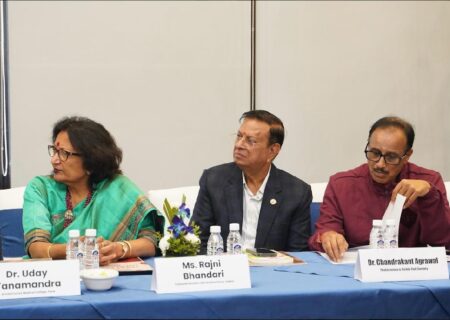Link between Urine infection and kidney stones
Dr. Sanman Gowda, Urologist, KMC Hospital, Mangalore Introduction Kidney stones is a major problem that is on the rise among people of all age groups across the world. The worldwide prevalence of renal stone disease

- Dr. Sanman Gowda, Urologist, KMC Hospital, Mangalore
Introduction
Kidney stones is a major problem that is on the rise among people of all age groups across the world. The worldwide prevalence of renal stone disease is estimated between 2% and 20%.
The highest incidence occurs in the age group 25 – 45years and declines after age of 50.
Urinary stones are more common in women than men due to high prevalence of urinary tract infections.
Incidence of stone occurrence is higher during summer. Climate, temperature and humidity are important factors for hydration status of the body which determine the stone formation.
Stone disease can occur in any part of urinary tract, more commonly in kidneys followed by ureter and bladder. Size of the stone is also variable starting from millimeters to centimeters.
Other risk factors like reduced water intake (Less than 1liter/day), food habits and medications can influence the stone formation.
Nephrolithiasis and urinary tract infection must be viewed in two ways.
- The first is stone disease that develops as a result of recurrent UTI caused by organisms that produce urease (infection stones).
- The second is nephrolithiasis complicated by UTI that occurs as a result of obstruction by a stone that has formed secondary to metabolic disease.
A close communication and collaboration between the urologist and the infectious disease specialist are essential to ensure a successful outcome for the patient.
Infection Stones
Infection with uropathogens can lead to the development infection stones, which serve as a continued source of recurrent infection and can lead to chronic kidney disease.
Infection stones are characterized by rapid growth and create a cast of the collecting system. Stones may form in time periods as short as 4 to 6 weeks. Stones with a branched configuration in two or more calyces are called as staghorn calculi.
Risk factors for stone development, includes urinary tract obstruction, Diabetes, urinary diversion procedures, indwelling catheters, distal renal tubular acidosis, and medullary sponge kidney, Neurogenic bladder, Renal transplant recipients, Cystic fibrosis.
Symptoms:
Kidney stones do not cause any symptoms unless they obstruct the urine flow. When the urine flow is obstructed, ureter dilates and stretches causing muscle spasms felt as cramping pain in the area of flank or abdomen.
Other symptoms include blood in the urine, fever, chills, vomiting, foul smelling urine.
In severe kidney infections due to obstructing stone; patient can go in sepsis leading to multiorgan failure.
Diagnosis:
- Ultrasound abdomen: It the first imaging investigation in a suspected stone disease.
- CT Abdomen: This is a confirmatory imaging modality in patients where stone is not visible on USG. Due to radiation exposure, it is not the initial modality of choice especially in pregnant patients and children.
- Urine microscopy: To know presence crystals, bacteria and hematuria
- Urine culture: To know the presence of infection by a specific organism and also to determine the antibiotic sensitivity pattern.
- Metabolic workup: Done in recurrent stone formers.
Management of Stones and Infection:
The treatment options in a stone disease depends upon the stone size, location, nature of the stone and patient’s condition. It ranges from managing conservatively to removing the stone surgically. With the advent of newer endoscopic technologies like LASER and RIRS, the need for open surgery has reduced drastically.
For Renal calculus which are very small(<5-6mm) and asymptomatic; dietary advice and adequate hydration is sufficient. However, for larger stones preferred treatment options include PCNL or MiniPCNL (Percutaneous nephrolithotomy) or URSL (Ureterorenoscopic lithotripsy) or RIRS (Retrograde intrarenal surgery) using LASER or Pneumatic lithotripsy. In certain patients with pyelonephritis and severe infection especially associated with diabetes; they will require temporary DJ stenting followed by definitive stone clearance at a later date once the infection resolve.
For ureteric calculus which are less than 7mm and no features of sepsis; conservative medical management can be recommended for 7 days followed by reimaging with USG to assess the stone passage. Persisting stone after treatment course will require endoscopic stone clearance.
Larger stones >7mm will usually require endoscopic surgery (URSL) followed by DJ stenting. In certain situations there can be pus draining from the ureter due to infected stone where temporary stenting is essential to prevent patient going into urosepsis. Stone is cleared at a second setting.
For renal stones <1.5cm ESWL (Extracorporeal shock wave lithotripsy) can be attempted.
Antibiotic prophylaxis (perioperative) should be provided for all patients. It should be guided by susceptibility results of a urine culture prior to procedure.
Although urine cultures may become negative at the conclusion of therapy, infection stones continue to harbor bacteria, that serves as a source of relapsing infections; hence requires complete removal stones.
Conclusion:
It is advisable to adapt to a healthy lifestyle and drink plenty of water to make up to the fluid loss in hot and dry climate. Water intake should be divided in the entire day over 7-8 times (Total of 1.5-2liter/day).
Avoid oxalate rich food (spinach, tomatoes, cashews, beer, chocolates and coffee) and high uric acid food (meat, cauliflower). Certain pain medications like NSAID(Ibuprofen, diclofenac, nimesulide) should not be taken as they are injurious to kidney.
Good glycemic control in diabetics is very essential along with treating other comorbid conditions.
Seek medical attention immediately in the event of severe flank pain, fever, chills, burning micturition, blood in urine which may the warning signs of urosepsis due to obstructing stone.






